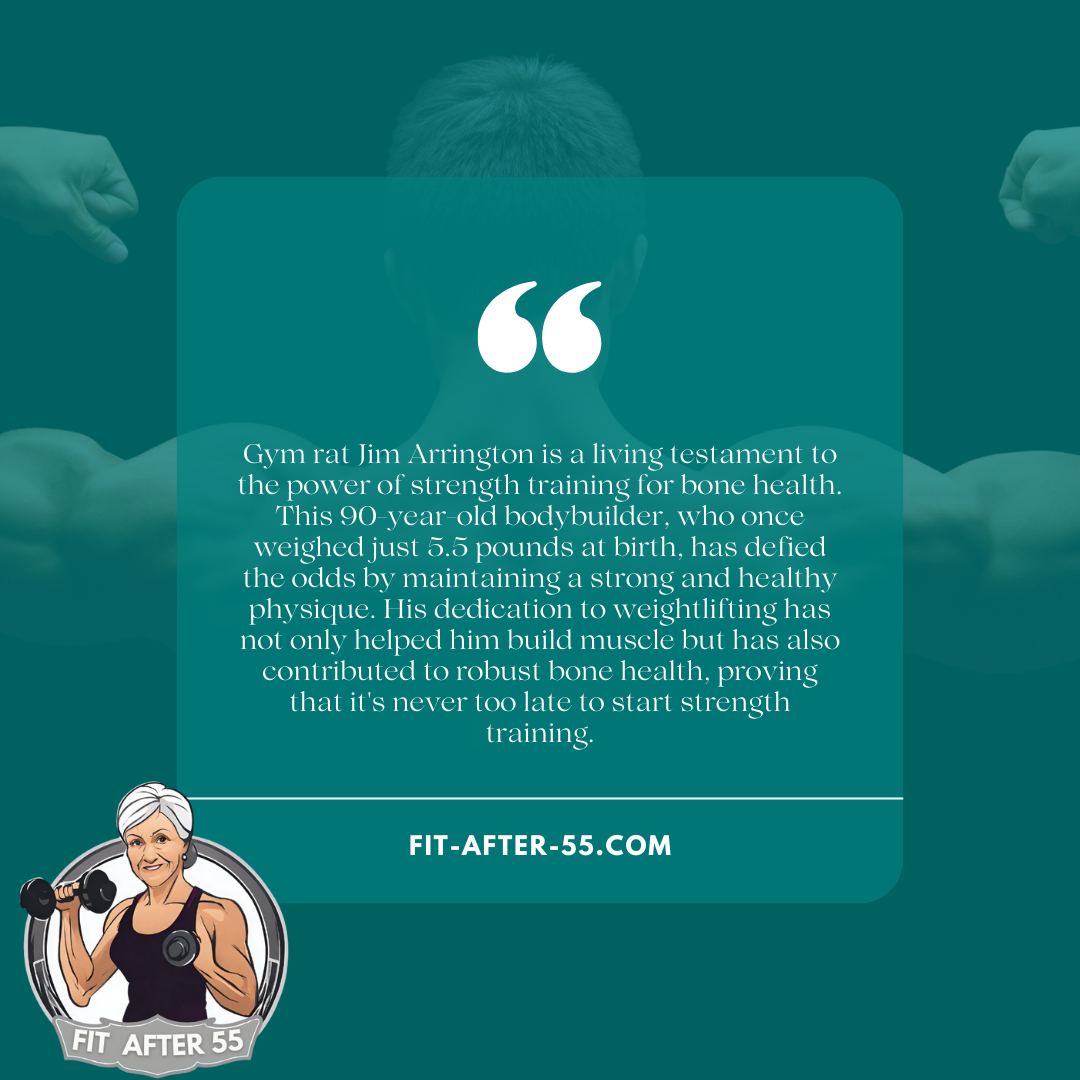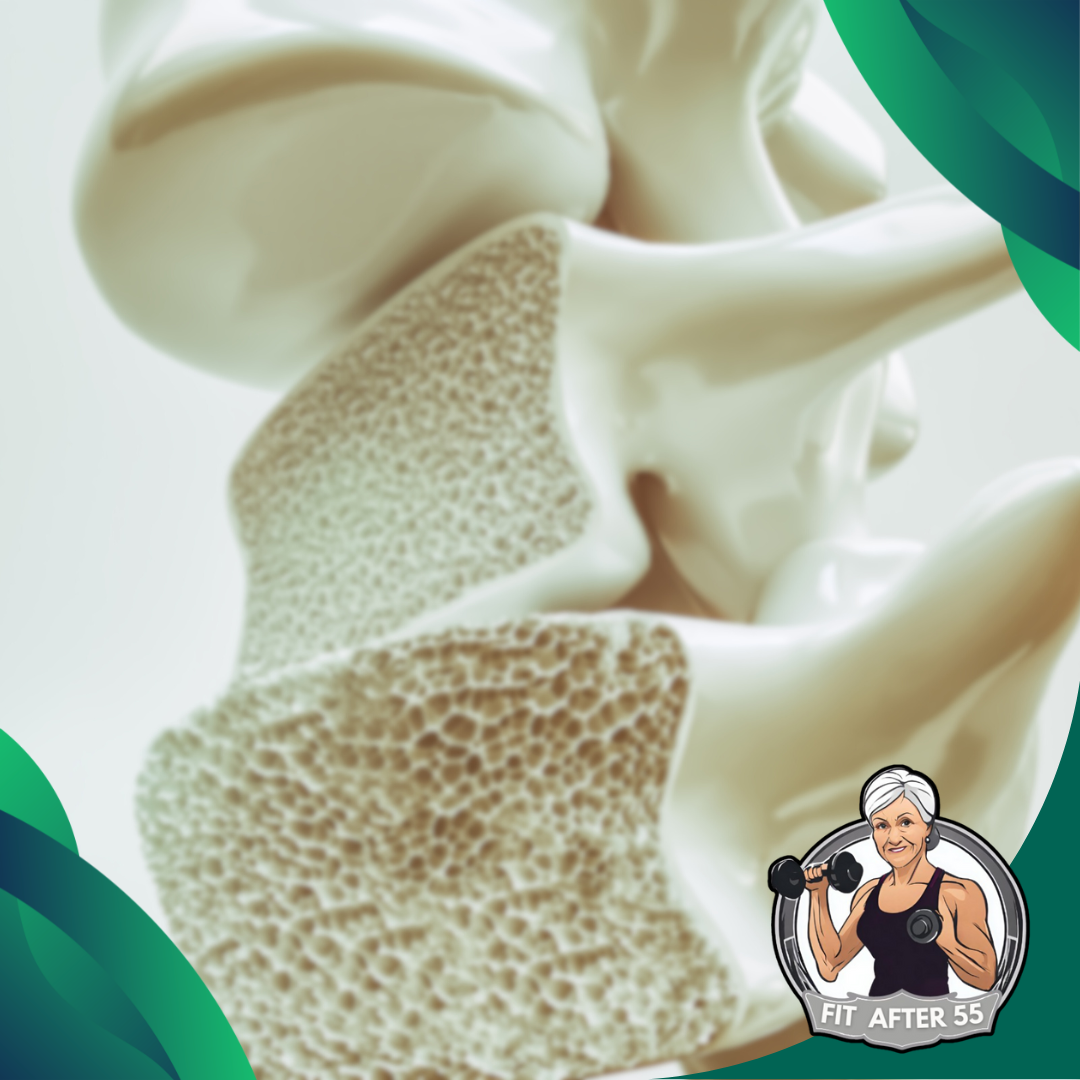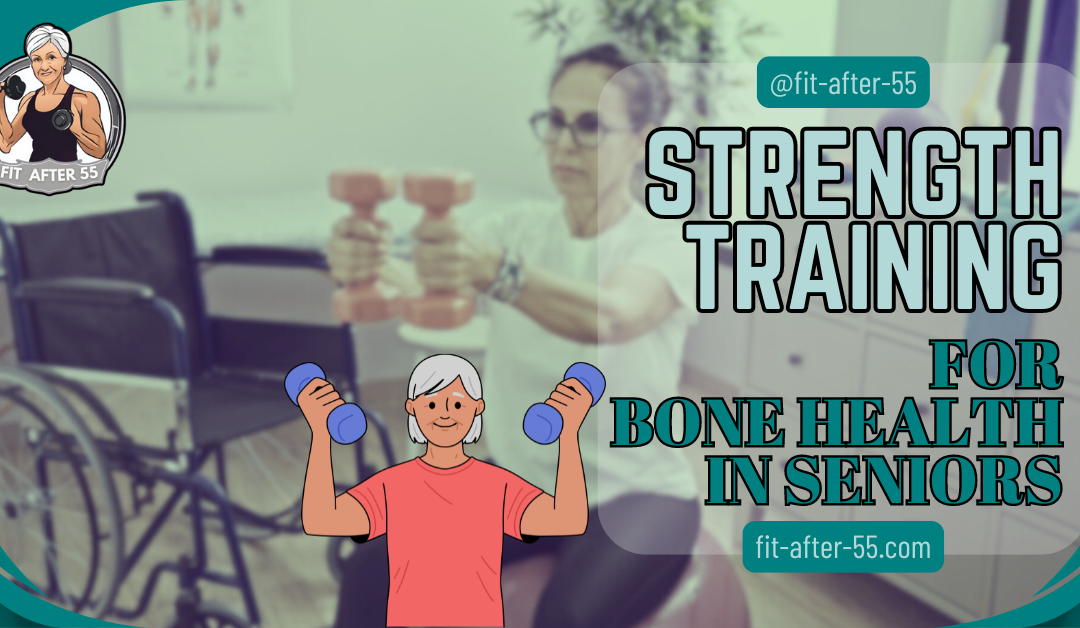Bone Health In Seniors: It’s a topic that often gets overlooked, but it’s a crucial aspect of aging well. Strong bones are essential for maintaining independence, preventing falls, and reducing the risk of fractures. As we age, our bones naturally become more brittle, making it even more important to prioritize bone health. In this article, we’ll discuss the factors contributing to osteoporosis, the benefits of strength training for seniors, and the role of nutrition in supporting bone health.
Bone Health In Seniors: The Power of Strength Training to Combat Osteoporosis
Strength training is often associated with building muscle mass and improving physical appearance. However, for seniors, it offers a much more significant benefit: protecting against osteoporosis. As we age, our bones naturally become thinner and more brittle, making us more susceptible to fractures. Strength training can help counteract this process by stimulating bone growth and increasing bone density.

Key Takeaways:
-
Bone Health is Crucial for Seniors: As we age, our bones become weaker, increasing the risk of fractures and falls. This can significantly impact independence and quality of life.
-
Strength Training is Key: Strength training helps combat osteoporosis, a major concern for seniors. It stimulates bone growth and increases bone density, making bones stronger and less prone to breaks.
-
Nutrition Matters: A balanced diet rich in calcium, vitamin D, and protein plays a vital role in bone health. These nutrients work together to build and maintain strong bones. Consulting with a healthcare professional or dietician can help ensure you’re getting the right nutrients for optimal bone health.

Maintaining Bone Health In Seniors – Critical for Health
Bone health becomes increasingly important as we age, especially for seniors. In fact, osteoporosis is a leading cause of hospitalizations and even death in people over 65. According to BoneHealthandOsteoporosis.org, “The disease is responsible for an estimated two million broken bones per year, yet nearly 80 percent of older Americans who suffer bone breaks are not tested or treated for osteoporosis. One in two women and up to one in four men over age 50 will break a bone due to osteoporosis.”
As I get older, I’m becoming more aware of how fragile our bones can become. The natural loss of bone density increases the risk of fractures, and it’s crucial for me—and for all seniors—to understand why our bones need extra care as the years go by.

Osteoporosis factors
Osteoporosis, a condition that leads to brittle and fragile bones, becomes a major health concern as we age. The risk of developing it depends on several factors, including genetics, lifestyle, and nutrition. For me, this highlights that taking care of my bones isn’t just about following a doctor’s advice—it’s essential for maintaining mobility and independence as I get older.
Strong bones support muscles and protect organs, both of which are crucial for daily activities. When bone density declines, the risk of injury rises, which can drastically affect a senior’s quality of life. That’s why I see preserving bone strength as an investment in my future, where I hope to stay active and avoid preventable limitations.
With a better understanding of the importance of bone health, strength training now feels like a key part of my strategy. It’s not just about lifting weights—it’s about building the strength to protect what aging tries to take away. Next, we’ll dive into the benefits of strength training for seniors and how it can play a vital role in maintaining and even improving bone density.

The Fundamentals of Strength Training for Seniors
Many people mistakenly believe that strength training is just for the young or for bodybuilders. In reality, it’s just as essential for seniors. Strength training, which includes exercises designed to improve muscle strength and endurance, plays a crucial role in maintaining and even enhancing bone density as we age.
As we get older, the natural loss of bone density can be fought with regular strength training. Bones, like muscles, respond to the stress placed on them. Just as muscles grow stronger with exercise, bones become denser when subjected to the force from these activities. So how does this work? It’s through a process called bone remodeling, where the strain from strength training activates bone-forming cells, ultimately leading to stronger, healthier bones.

Low Impact vs High Impact
When choosing strength training exercises for seniors, it’s important to focus on low-impact movements and start at a level that matches their current fitness. Good examples include resistance bands, light free weights, or bodyweight exercises like wall push-ups. The key is to start slow and gradually increase the intensity as strength and confidence improve.
Before beginning any strength training routine, it’s essential for seniors to have their health evaluated by a medical professional. This ensures the program is tailored to their specific needs, taking into account any pre-existing conditions or mobility issues. With the right approach, strength training can offer numerous benefits beyond bone health, including better balance, coordination, and an enhanced quality of life.

Safe Practices and Injury Prevention
When seniors begin strength training, the top priority is avoiding injury while still gaining the health benefits. It’s important to recognize personal limits and start slowly, gradually increasing intensity at a comfortable pace. Exercises should be selected not only for their effectiveness but also for their safety.
One of the best approaches is to gradually incorporate weight-bearing exercises, which can strengthen bones without causing unnecessary strain. Starting with light weights, resistance bands, or just body weight helps build a solid and safe foundation. Focusing on proper form rather than lifting heavy weights is crucial for maintaining correct posture and movement, reducing the risk of strains or fractures.
Seeking professional guidance is equally important. A physical therapist or certified trainer who specializes in geriatric fitness can design a strength training program tailored to each person’s specific needs. They can also track progress and adjust exercises to prevent overexertion, ensuring a safe and effective routine.

Remember Those Warm Ups
Stretching and warm-up exercises are the first line of defense against injury. Incorporating dynamic stretches before and static stretches after strength training helps improve flexibility and lowers the risk of muscle strains or tears. It’s also essential to stay hydrated and listen to your body—if something feels painful, it’s better to stop rather than push through.
Safe strength training for seniors isn’t just about lifting weights; it also includes exercises that improve balance and coordination. These are crucial for preventing falls, which can seriously impact bone health. Adding activities like tai chi or basic balance drills can make a big difference in reducing the risk of falls and the injuries that come with them.
Nutrition’s Role in Bone Health and Strength Training
“You are what you eat.” This age-old saying is especially true for seniors focusing on bone health through strength training. Just like building a house requires a solid plan and the right materials, strengthening bones requires both the right exercises and essential nutrients.
Calcium is at the heart of bone health, serving as the building block for strong bones. It’s important to get enough of it every day. Vitamin D works hand-in-hand with calcium, helping it absorb into the bones. Seniors should focus on foods rich in these nutrients, like dairy products, leafy greens, and fortified foods, or consider supplements if recommended by a healthcare provider.
Protein is the often-overlooked hero, vital for maintaining and repairing muscle, which is closely linked to bone strength. Foods like eggs, lean meats, and legumes are excellent sources. However, balance is key—focusing too much on one nutrient can sometimes reduce the intake of others, so it’s important to maintain variety in the diet.

Proteins Helpers
Other minerals and vitamins like magnesium, potassium, and vitamins K and C also play important roles in maintaining optimal bone health. Snacking on fruits, vegetables, nuts, and whole grains can help you get a balanced intake of these essential nutrients.
When discussing nutrition for bone health with seniors, I always emphasize the importance of hydration as well. Staying hydrated affects your strength and energy levels, which in turn impacts how effectively you can engage in strength training. Drinking enough water is a simple but crucial part of your daily routine.
From personal experience, I’ve found that consulting with a dietitian can be incredibly helpful in creating a dietary plan that complements your strength training routine. It’s all about aligning your nutrition with your physical activity to build and maintain strong, healthy bones.
With the right nutritional foundation, you’ll be well-equipped for success in your strength training journey. In the next section, we’ll hear from individuals who have followed this path. Their stories will not only inspire you but also provide real-world evidence of the positive impact that strength training and proper nutrition can have on a senior’s life.
Real-life Success Stories: Strength Training’s Impact on Seniors
You might be wondering if real people, people you can relate to, have found success with strength training later in life. The answer is a resounding YES.
I’ve heard countless stories of elderly individuals who transformed their lives through regular strength exercises. One inspiring example is a 70-year-old woman who started strength training after suffering a fracture from a fall. A few months later, her balance improved, and so did her confidence.

From speaking with these remarkable seniors, I’ve learned that the beginning is always the toughest part. But it’s their persistence and the support of trainers and healthcare providers that make all the difference. Hearing their successes and challenges is a powerful reminder that it’s never too late to start and see real progress.
Healthcare professionals, including physiotherapists and geriatricians, also report amazing results in their patients who adopt strength training. They’ve seen improvements like better mobility, reduced arthritis pain, and even less reliance on medications.
These stories, along with others I’ve read and heard, really underscore the value of strength training for improving bone health and overall quality of life in seniors.
Actionable Advice?
Begin your journey with healthcare advice, get the right guidance, and be patient with yourself. Your future self will thank you for the strength you build today.
New Trends and Tips for Making Strength Training a Breeze
What’s New in Bone Health Research
Let’s talk about some of the cool things happening in bone health research. Recent studies have shown that even low-impact strength training can have a big impact on your bone density. For example, a 2023 study found that adding balance exercises to your routine can really cut down on falls. Keeping up with these findings can help us tweak our routines to get the best results.
Tech to the Rescue
Technology is also stepping in to help us stay on track. Wearable devices like fitness trackers and smartwatches are now more advanced than ever. They can monitor everything from bone density to your exercise form. These gadgets can be great motivators and ensure you’re doing your exercises right. It’s worth checking out these new tools—they might make your workouts more effective and fun.
Easy Tips for Fitting Strength Training into Your Life
Making strength training part of your daily routine doesn’t have to be a hassle. Here are some tips to make it easier:
- Set Small Goals: Start with achievable goals to build your confidence. Little wins add up!
- Choose Fun Activities: Pick exercises you enjoy, whether it’s a dance class or lifting light weights.
- Get Social: Invite a friend or join a class. It’s a great way to stay motivated and make it more enjoyable.
- Stick to a Schedule: Treat your workout like any other important appointment. Consistency is key!
Keep Checking In
Lastly, remember to revisit your strength training routine from time to time. As you progress, your needs might change, so regular check-ins with a fitness pro can help you adjust your program. They can help you stay on track and make sure your routine is always hitting the mark.
Bone Health in Seniors: Building a Strong Foundation for the Future
We’ve covered a lot of ground in this article. From understanding the factors contributing to osteoporosis to exploring the benefits of strength training and the role of nutrition, we’ve painted a clear picture of how seniors can proactively protect their bone health.

By incorporating strength training into your daily routine and ensuring you’re getting the right nutrients, you can significantly reduce your risk of fractures and maintain your independence as you age.
Thank you for taking the time to learn more about bone health. Remember, it’s never too late to start. Take the first step today by consulting with a healthcare professional.
Let’s work together to build a stronger, healthier future.
FAQs about Bone Health and Strength Training for Seniors
Here are four questions that delve into specific aspects of bone health and strength training for seniors:
How can strength training help prevent falls in seniors?
Strength training improves balance, coordination, and muscle strength, all of which are crucial for preventing falls. Stronger muscles can help you react quickly to maintain your balance, reducing the risk of trips and slips.
What are some common misconceptions about strength training for seniors?
One common misconception is that strength training is only for young people or bodybuilders. In reality, it’s just as important for seniors to maintain and improve their bone health and muscle strength. Another misconception is that it’s too dangerous for seniors. While it’s important to start slowly and choose low-impact exercises, strength training can be done safely with the right guidance.
How can I incorporate strength training into my daily routine if I have limited mobility?
There are many ways to incorporate strength training into your daily routine, even if you have limited mobility. You can start with exercises that you can do while sitting, such as arm curls or leg extensions. You can also use resistance bands or light weights to add resistance to your exercises. As your strength and mobility improve, you can gradually increase the intensity of your workouts.
Are there any dietary supplements that can help support bone health in addition to strength training?
While a balanced diet is essential for bone health, some dietary supplements can be helpful. Calcium and vitamin D are two important nutrients for bone health. If you’re not getting enough of these nutrients from your diet, your doctor may recommend taking supplements. However, it’s important to consult with your doctor before taking any supplements.
Discover More and Join the Community!
Looking to stay fit and healthy as you age? Dive into our official site for engaging content, expert product reviews, and practical tips tailored just for you. Connect with a supportive community on our Facebook page and be part of the conversation about elderly fitness and overall wellness. Join us today and take the next step towards a stronger, healthier you!

